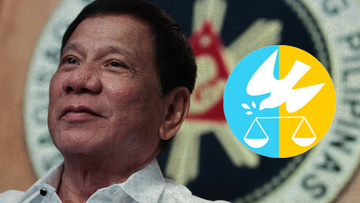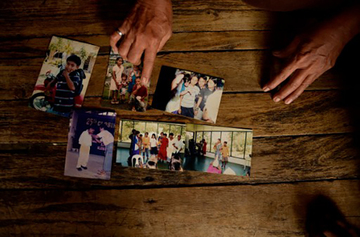
MANILA, Philippines – Then Davao City mayor Rodrigo Duterte appeared on March 30, 2009 before a public inquiry organized to probe into the summary killings allegedly done by the Davao Death Squad (DDS).
According to a Newsbreak report, then Commission on Human Rights (CHR) chairperson Leila De Lima explained that the full-blown investigation was initiated because the killings were “getting alarming.” She added that it was high time for the country’s main human rights institution to emphasize that killing “is wrong, legally and morally, even assuming that these are criminal elements.”
Eight years later in 2017, Duterte is president and De Lima, although elected senator, is in jail over her alleged involved in the drug trade inside the national penitentiary. (READ: TIMELINE: De Lima – from drug probe to arrest)
The embattled senator claimed that she was being persecuted because she has been one of the most consistent critics of Duterte. The Davao strongman, however, has said that no charges were ever filed over his alleged involvement in the DDS.
Many have referred to the 2009 investigation into the DDS as the starting point of the bitter spat between the two. What exactly happened when Duterte faced the CHR?
There are killings but not summary
Duterte was the first person to speak from about 39 respondents – local and national government officials, police officers, and “non-state actors” – summoned by the CHR for the March 30 event.
According to documents obtained by Rappler, the questioning mainly revolved around:
- Existence of summary killings allegedly attributable to the DDS
- What the local government is doing regarding the unsolved killings, particularly those of minors, in Davao City
- How the local government deals with criminality in the city
De Lima was the main commissioner who threw questions at the then Davao City mayor, based on transcripts of stenographic notes from the hearing.
While denying the existence of a death squad or the local government’s involvement in summary killings under his watch, Duterte offered his resignation if any evidence proved otherwise.
He, however, acknowledged that there were “unexplained, unresolved” killings in Davao City.
“If you mean summary killings in this sense that he is tied, a person is tied, or youth offenders, there is none because I have not seen one,” Duterte told De Lima in 2009. “But there are killings here, unexplained, unresolved, no proof, until now results or evidence reveal that they were killed by whom or for what.”
According to CHR documents, there were about 742 unsolved killings in Davao City from 2005 to 2009.
While the DDS was accused of killing over 1,000 people since it was established, the CHR identified 206 deaths attributable to the squad in the same period. Out of this number, 90 were “shot or stabbed by motorcycle-riding assailants.” They also used .45 caliber handguns.
Duterte, however, disagreed with pinning the blame on a specific group, despite the pattern, because “firearms are easy to obtain this country.”
But he insisted before the CHR that if a government employee, military personnel, or a policeman was behind any of the unsolved killings, “they are doing it on their own.”
In fact, Duterte said that he called the office of CHR Regional Director Alberto Sipaco Jr – his fraternity brother at Lex Talionis – whenever there was an incident suspected to involve a state-actor.
“Whenever I suspect that there are government people involved, I would call him or I would refer it to the National Bureau of Investigation when I suspect that the police did it,” he claimed. “I would call his office and say please look into this because I think this is summary killing perpetrated by suspected military or police.”
The CHR regional director was the same person who allegedly told then-United States ambassador to the Philippines Kristie Kenny that Duterte knew about the killings and permits them, according to a confidential cable published by WikiLeaks. (READ: Duterte 'admitted complicity' in Davao killings – WikiLeaks)
But during the hearing, Duterte denied any involvement in the killings. He, however, took full responsibility for the unsolved killings under his watch as mayor.
“I take full responsibility for it, the failure [of solving killings],” he explained. “It means to say that it is the job of the city mayor to see to it that justice is done, that the causes of killings in the city should be solved to the extent for I have operational control of the city police… I take full responsibility for it.”
Duterte vs Pangilinan law
The death squad spared no one. Data from the CHR show that 19 minors were allegedly killed by the DDS between 2005 to 2009.
Among these victims who were minors were the Alia brothers: 18-year-old Richard, 17-year-old Christopher, 14-year-old Bobby, and 15-year-old Fernando. They were killed one after another between July 2001 and April 2007.
Duterte, however, said during the public hearing that deaths of minors in his city were probably due to gang wars.
“Sinabi ko sa inyo na itong mga minors na ito they are out to cut each other’s throat,” he said. “Walang police na gago pati mayor na papatay, it has something to do with the lapses with the law.”
(I am telling you that the minors here are out to cut each other’s throat. No police nor mayor in his right mind will kill minors. It has something to do with the lapses with the law.)
Duterte blamed Republic Act Number 9344 or the Juvenile Delinquency Act of 2006 for hindering local authorities from controlling violence among minors in his city.
RA 9344, also known as the Pangilinan Law after its author Senator Francis Pangilinan, raised the minimum age of criminal responsibility from 9 to 15 years old.
“Alam mo dito pag aresto ka (You know when you're arreted here), you are below 15, you go out of jail immediately,” he explained.
“There’s not even a mechanism na pag na-aresto mo iyan, maski i-detain mo na lang nang isang linggo, i-lecture on the responsibility of a good citizen, wala na. Out na agad.”
(When a person below 15 years old is arrested, you go out of jail immediately. There’s not even a mechanism that when you are arrested, you can be detained even for just one week where you will be lectured on the responsibility of a good citizen. There’s none. You’re released immediately.)
Although there were local programs focused on helping at-risk youth, Duterte was more concerned with minors who already had a reputation of being involved in criminal activities. They allegedly had a tendency to retaliate and resort to more crimes.
It is then no wonder that when he became president, one of his legislative priorities was to lower the age of criminal responsibility in the Philippines. (READ: Duterte wants to amend Juvenile Justice Law)
Davao City ‘a dangerous place for criminals’
Opposition to the Pangilinan law was not the only thing Duterte brought to the national level when he was elected. His public pronouncements as president on how to deal with criminals were the same as when he was still mayor: Do not be afraid to shoot for self-defense.
“If you are arresting him for a crime and if he resists violently, then you have to shoot him, as simple as that,” he said during the 2009 hearing. “Now, my lecture to them is that you announce your authority, that you have to take him to court, but if he puts up a fight and you feel that your life is in danger, shoot. That’s your job.”
Now, less than a year into his presidency, there have been over 7,000 deaths, both from legitimate police operations and vigilante-style or unexplained killings. (READ: IN NUMBERS: The Philippines' 'war on drugs’)
Majority, if not all, of those killed by police allegedly fought back. (READ: 'Nanlaban sila': Duterte's war on drugs)
Duterte’s firm and violent stand against criminality was really evident even from the start – though he claimed, “I know the limits of what I can say and what I could do.”
“When I became mayor in 1998, Davaoeños know this, I made a statement, a very disturbing statement that I would make Davao City the most dangerous place for criminals,” he said during the public hearing. “It is my duty as mayor and I am responsible for the uplift of this community, for the lives, for the peace and order.”
“I took my oath of office that I would protect everybody and my order to the police is that every woman or child who comes home to their houses must be unmolested and undisturbed,” he added.
Investigation records of CHR stated that at least 107 victims between 2005 to 2009 had records or were suspected to have been involved in illegal activities. There were several instances of mistaken identity.
But when asked by De Lima regarding the criminals summarily killed, Duterte said that he does not go after “small crimes” as his priorities were to eliminate illegal drugs.
New investigation after 8 years
In 2012, the main office of the CHR released a resolution saying that it found "probable cause" and recommended that the Ombudsman investigate the "possible administrative and criminal liability" of Duterte in relation to the killings under his watch as Davao City mayor. (READ: Davao Death Squad: What ever happened to the investigations?)
The investigation at the Ombudsman, however, was “closed and terminated.”
A fact-finding report, dated May 5, 2014 and submitted by the Field Investigation Office to Overall Deputy Ombudsman Arthur Carandang, quoted Sipaco’s statement that his office does not have any proof that the death squad does exist. The report also echoed his statement that the allegations remain as "chismis and other gossips” because of lack of witnesses.
But 3 years later, self-confessed DDS member Edgar Matobato came forward and implicated Duterte in the death squad. Retired policeman Arturo “Arthur” Lascañas also retracted his prior denial.
With the addition of Matobato and Lascañas, the number of alleged DDS members who came forward and confessed rose to 6. Four submitted their sworn affidavits earlier in 2009. (READ: Lascañas, Matobato were not the first DDS whistle-blowers)
These testimonies have prompted the CHR to form a new team to probe into the killings allegedly carried out by the known death squad.
Will Duterte again appear before the CHR during such a probe? – Rappler.com


No comments:
Post a Comment